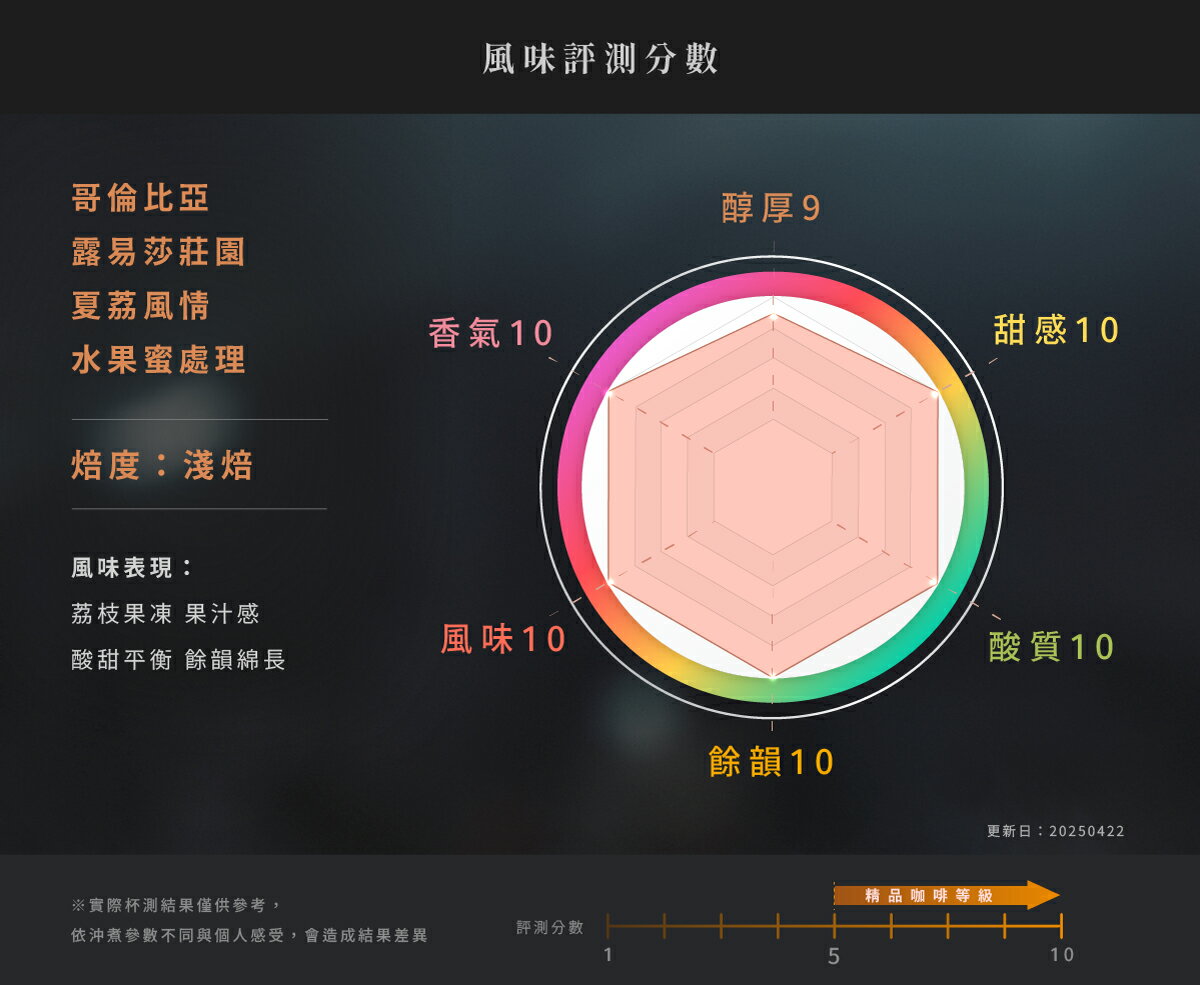

Colombia Antioquia Finca La Luisa Lychee Fruit Honey Process Specialty Coffee, Options:
Colombia Antioquia Finca La Luisa Lychee Fruit Honey

Colombia Antioquia Finca La Luisa Peach Fruit Honey








Coffee Flavor
The flavors of coffee are derived from the breakdown of various nutrients in the green coffee beans during roasting. Heat causes these compounds to degrade into a variety of aromatic molecular structures, resulting in a wide spectrum of flavors. High-quality coffee beans naturally possess a rich aroma that evolves at different temperatures—high, medium, and low—offering a delightful and nuanced experience worth savoring.
Colombia Antioquia Finca La Luisa Lychee Fruit Honey
Lychee jelly, juicy, balanced sweet and sour, long-lasting aftertaste.
Colombia Antioquia Finca La Luisa Peach Fruit Honey
White peach, fragrant sweet peach, full-bodied juicy texture, smooth and sweet lingering finish.

Finca La Luisa - From Farm to Coffee Experimentation Estate
Finca La Luisa is nestled in one of the most ideal coffee-growing regions of Antioquia province. With nearly 100 years of dedication to coffee cultivation, the estate's owner is committed to ensuring coffee traceability, environmental conservation and maintenance, and the quality assurance of the coffee itself. Situated at an altitude exceeding 1700 meters above sea level, the farm's unique climatic conditions, fertile volcanic soil, and the protected native tropical rainforest surrounding the coffee-growing areas make this an ideal location for guaranteeing crop quality and stable yields.
Until five years ago, the current owner, Juan Pablo, decided to specialize in producing specialty coffee and planned small-scale experimental varieties such as Geisha, Pacamara, and Tabi. He aimed to forge a different path by combining natural, honey, and experimental fermentation processing methods. His initial fermentation experiments involved carbon dioxide maceration in plastic drums. To experiment with larger volumes, Juan purchased large stainless steel tanks used for brewing beer. The results of these tests revealed surprisingly outstanding flavors! Juan explored various fermentation processing techniques, utilizing different microorganisms, yeasts, and even less common and more unique fermentation methods like fruit juices and liqueurs. Through these repeated experiments, the Fruit Honey process was born.
The variety used for the Fruit Honey process is Caturra, a descendant of Arabica known for its mellow, sweet, and smooth flavor. Using fruit juice as the fermentation medium for the Fruit Honey process yields a fresh and natural fruit flavor. "Peach Paradise" offers the aroma of California dried peaches with the sweet and tart notes of plum. The flavor of "Summer Lychee Romance" is remarkably similar to lychee jelly, with a fresh and natural sweetness.

The Arabica coffee variety, Caturra
The coffee tree, botanically classified under the Rubiaceae family and the Coffea subgenus, is an evergreen tree. Coffee beans are the seeds of the coffee fruit. There are three main varieties: Arabica, Robusta, and Liberica. These three varieties cannot crossbreed to produce different subspecies. The world’s specialty coffee comes from the Arabica variety, and within Arabica, there are various subspecies resulting from evolution, hybridization, and mutation.
Caturra, the Arabica coffee variety, is a mutant of Bourbon and was first discovered in Brazil. The taste has a sour taste of lemon or citrus, and it has a fruity taste in terms of sweetness. Although the sweetness is not as good as Typica and Bourbon, the sweetness can be very good when properly roasted. The sweetness of Caturra is determined by the number and dosage of fertilizers applied by the grower, and the harvest period takes 2 years, and the cost of care is high, so the yield is still limited.

(Coffee Processes)
The term "processing methods" refers to the process of transforming ripe red coffee cherries into dried green beans. Each method has its advantages and disadvantages, influenced by the natural environment and the specific needs of the coffee-producing region. As a result, different regions adopt the processing method most suited to their conditions. This batch uses the Fruit Honey, briefly described as follows:
【Fruit Honey】
The harvested ripe coffee cherries are placed in stainless steel tanks, and carbon dioxide is injected to create a completely anaerobic (oxygen-free) environment. The coffee cherries ferment in this environment for approximately 5 days. During the fermentation process, the washing station collects the juice from the coffee cherries.
Once the fermentation is complete, the coffee cherries go through a pulping machine to remove the fruit flesh. They are then mixed with the previously collected cherry juice and selected fruit juice for a second fermentation stage lasting 3 days.
Finally, the coffee is shade-dried for 5 days to reach the target moisture content.
Fruit Honey Processing Steps:
The first step involves placing the coffee cherries into pressurized stainless steel tanks and injecting carbon dioxide to create an anaerobic environment. The coffee cherries ferment in the tanks for five days. After fermentation, the juice from the coffee cherries is collected.
The fermented coffee cherries are depulped, and then undergo a second fruit fermentation.
The collected coffee cherry juice is mixed with "fruit juice" and fermented for three days. There are four types of "fruit juice" used: sweet peach, cantaloupe, strawberry, and lychee, resulting in the corresponding fruit flavors.
Finally, the coffee is slow-dried for five days to complete the entire processing.





JUSTIN INTERNATIONAL FOOD ENTERPRISE CO., LTD.
Tel: +886-3-358-6611
1st Floor, No. 30, Lane 120, Daxing Road, Taoyuan District, Taoyuan City
▶This product is covered by a NT$10 million product liability insurance.
▶Food Industry Registration Number: F-165601955-00000-0
▶ Our company’s cupper is certified as a CQI International Coffee Quality Appraiser.



Recommended Products



